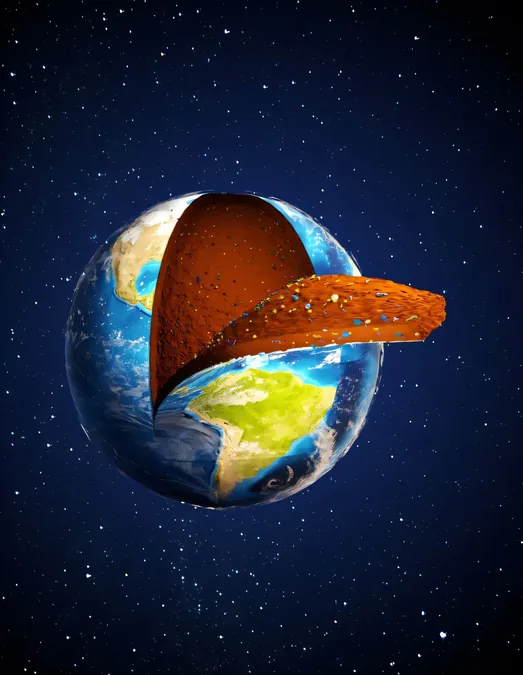
Groundbreaking Discovery: New Microbes Uncovered in Earth's Deep Soil Could Transform Water Purification
2025-04-07
Author: Wei Ling
Groundbreaking Discovery: New Microbes Uncovered in Earth's Deep Soil Could Transform Water Purification
In a remarkable scientific breakthrough, researchers have identified a new phylum of microbes, known as CSP1-3, residing in the depths of Earth's Critical Zone, an essential region of deep soil that plays a crucial role in restoring water quality. As water makes its way through the soil, these microbes actively consume remaining pollutants, potentially revolutionizing the way we understand natural water filtration systems. Their findings, detailed in a study published in *Proceedings of the National Academy of Sciences*, shed light on an area of our planet that has remained largely unexplored.
Echoing the wisdom of Leonardo da Vinci, who once remarked, "We know more about the movement of celestial bodies than about the soil underfoot," lead researcher James Tiedje, a microbiologist at Michigan State University, is committed to changing our perception of soil's importance. He describes the Critical Zone, which extends from treetops to depths of up to 700 feet, as the "living skin" of our planet that supports life through the regulation of vital processes such as soil formation, water cycling, and nutrient dynamics, all critical for ecosystem health, food production, and clean water supply.
Exploring the Mystery of the Critical Zone
Tiedje's research team explored deep soil samples from Iowa and China, where they discovered the new CSP1-3 phylum at depths reaching 70 feet. These locations were selected for their similar soil characteristics; researchers aimed to determine if the presence of these microbes was widespread beyond localized areas. Upon extracting DNA from these samples, the team uncovered that CSP1-3's ancestors had once thrived in aquatic environments like hot springs millions of years ago before adapting to soil habitats.
One key revelation was that these microbes are not just dormant organisms, as one might expect, but are surprisingly active and growing. In contrast to what is typically found in surface soils, CSP1-3 makes up a staggering 50% or more of the microbial community in deep soils, showcasing a profound adaptability to their nutrient-poor environment. "The deep soil offers a unique setting, and these organisms have evolved to thrive there through extensive adaptation processes," Tiedje explained.
The Crucial Role of CSP1-3 in Water Purification
Often referred to as the planet's largest natural water filters, soils purify water through a combination of physical, chemical, and biological processes. While surface soils have limited filtration capabilities due to their size, deep soils—where CSP1-3 resides—can significantly enhance this process. These microbes utilize carbon and nitrogen that have percolated down from upper layers of soil, effectively scavenging pollutants that have bypassed the surface.
"The CSP1-3 microbes play a vital role in cleaning up contaminants that have filtered through," Tiedje noted. "They are nature's own recyclers and water quality enhancers."
What Lies Ahead for Microbial Research?
Tiedje's team now faces the challenge of culturing these microbes in the laboratory. If successful, this could unlock secrets about their unique physiological traits and adaptations that support survival in deep soil environments. Culturing these microbes is no easy task; many remain uncultured due to difficulties replicating their natural habitat. Tiedje's approach includes experimenting with high-temperature conditions, inspired by the microbial ancestors' origins in hot springs.
The potential of these microbes extends beyond ecological benefits; insight into their unique metabolic capabilities may lead to innovative solutions for environmental issues, particularly in the realm of pollution degradation. "We are still learning about their ability to metabolize complex contaminants," Tiedje remarked, emphasizing the importance of this research in addressing pressing global challenges.
As the study of CSP1-3 evolves, this discovery not only illuminates the hidden depths of our soil but also paves the way for groundbreaking applications in environmental management and water purification—an exciting prospect for future generations.
 Brasil (PT)
Brasil (PT)
 Canada (EN)
Canada (EN)
 Chile (ES)
Chile (ES)
 Česko (CS)
Česko (CS)
 대한민국 (KO)
대한민국 (KO)
 España (ES)
España (ES)
 France (FR)
France (FR)
 Hong Kong (EN)
Hong Kong (EN)
 Italia (IT)
Italia (IT)
 日本 (JA)
日本 (JA)
 Magyarország (HU)
Magyarország (HU)
 Norge (NO)
Norge (NO)
 Polska (PL)
Polska (PL)
 Schweiz (DE)
Schweiz (DE)
 Singapore (EN)
Singapore (EN)
 Sverige (SV)
Sverige (SV)
 Suomi (FI)
Suomi (FI)
 Türkiye (TR)
Türkiye (TR)
 الإمارات العربية المتحدة (AR)
الإمارات العربية المتحدة (AR)